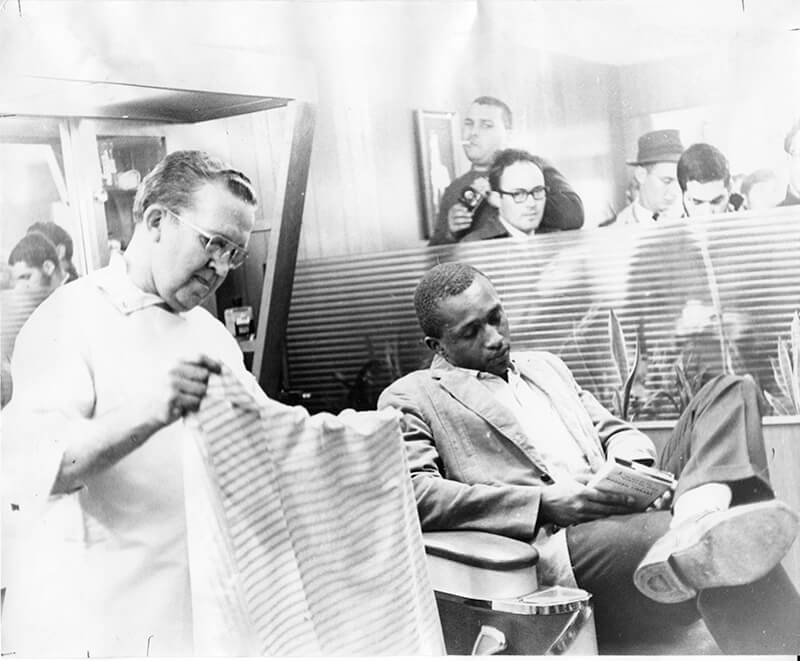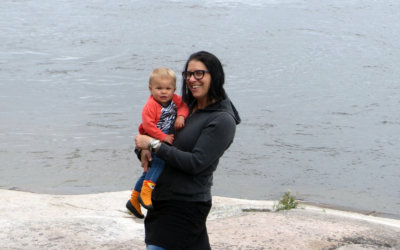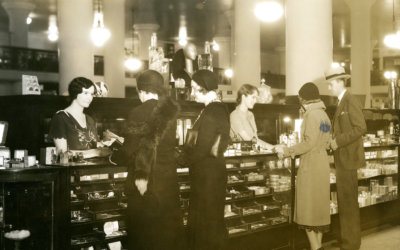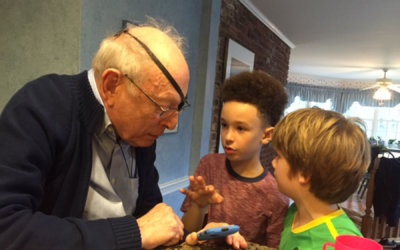Rozell “Prexy” Nesbitt spoke recently with student Truth Garrett ’20 about attending Antioch College, his work in Africa and liberation movement struggles, being Martin Luther King Jr.’s bodyguard, and how the College has shaped his career. This piece is based on their conversation.
Prexy Nesbitt ’67 first heard of Antioch College on suggestion from his father, who, during WWII was working as a civilian instructor at Wright Patterson Air Force Base in Dayton, OH, teaching pilots how to use their radios. At that time, Nesbitt explains, “He used to come over to Yellow Springs all the time because that was called the ‘oasis in the desert’ by Black folk who were around Wright Patt.” His father took him to see Antioch while they were out on a college tour trip.
“Well I got down there and went by the folk dancing that was on the Friday night and got so excited by all that folk dancing, I said, ‘Shoot, I’m going to apply to this place.’”
Beyond folk dancing, Antioch College introduced Nesbitt to the Antioch Education Abroad experience. “That was one of the real pivotal points in my development and in my exposure. Though I had traveled overseas just before I came to Antioch (I had lived in Sweden through a program called Experiment in International Living), I’d never been to Africa.” While he had planned to go to Rhodesia, due to a last minute visa denial, Nesbitt ended up in Tanzania at the University College of Dar es Salaam.
“I ended up going to spend a year at the University College of Dar es Salaam, which would be then the first trip of what would become about 25 trips over the next 10 or 15 years to just Tanzania, which was the center of the liberation movement struggles in southern Africa,” Nesbitt states.
Work Against Apartheid
After graduating from Antioch College, Nesbitt was instrumental in a project dealing with banking and financing in Africa. In 1970, he began work as a field organizer for the American Committee on Africa. “I started working, organizing professionally around trying to get people mobilized to fight the Apartheid government of South Africa and see the connection of that to the racism in the United States.”
Nesbitt left the position after three or four years because it wasn’t a career job, but in 1977, he was asked to come back to run a bank loan campaign. “That was a campaign to get people to withdraw their monies and cease banking with any banks that were involved in making loans to South Africa,” he explains. “We started a movement called the Committee to Oppose Bank Loans to South Africa. It had branches across the country, and we easily mobilized because we had great support from the unions, churches. Some cities withdrew their money from banks like Bank of America, Chase, Wells Fargo, and a number of other smaller banks that were involved in sending these loans that helped the Apartheid government run the military and run the oppressive machinery of the Apartheid regime.”
This important work preceded the passage of U.S. sanctions against South Africa, which included not having the U.S. government do any business with banks making loans. “It led to the banks withdrawing their money from supporting Apartheid, literally,” Nesbitt adds.
Activism at Antioch
At the time Nesbitt attended the College, Antioch sent more people to the South to do Civil Rights work than any other college its size. His parents, particularly his mother, wouldn’t let him go. Instead, Nesbitt got very involved in the fight to integrate Gegner’s Barbershop right in Yellow Springs. “The guy never did cut Black hair,” Nesbitt says. “I was the first Black person to sit in his barber’s chair and he responded to that by throwing his barber’s apron all over my head. Now, it was a nonviolent demonstration, so I couldn’t respond as I would have liked to have. I was marched out by Chief McGee and James Lawsom, who were both African Americans and the chief of police and town manager respectively, and it was a big event because there was a huge mobilization.” At the time, there were only nine or 10 Black students on Antioch’s campus, Nesbitt recalls, and Central State and Wilberforce students would join us to mobilize around issues.
As a student, Nesbitt was also involved in a variety of issues. . “I started Antiochians Concerned with Southern Africa, and we were protesting Antioch’s money involved with Chemical bank.” At one point, the group took over a Board of Trustees meeting, following the Trustees all over campus each time the group tried to assemble away from them. “They couldn’t figure out how we were able to follow them all over campus,” he adds. “It was because all of the workers—they were our buddies—so they told us every move they were going to make.” J.D. Dawson, dean of students, arranged an off-campus meeting, which eventually led to Antioch divesting from its portfolio any companies involved in South Africa.
Nesbitt was also involved in integrating Yellow Springs schools. “I ran a little club for white families to have their children play baseball and sports with Black families. It was a children’s club; it was an initiative of children. It was beautiful.” A shocking incident happened, though. At one point Nesbitt and one of the children in the group were shot at. “I was giving her a ride on my bicycle in the basket—she was a six- or seven-year old—and they almost killed her.”
People from surrounding towns, places like Xenia, would come through Yellow Springs and to Antioch’s campus regularly, “and hoot and call us names and throw stuff at us, especially those of us who were Black or mixed couples.” Also enrolled at the College were a group of former military officers. “They came to me one night and said, ‘Look Nesbitt, we see what’s happening here, and some of us have been talking, and we want to be available to you. So that you know that you can always turn to a group of us to respond and give you some back up.’” Those students became a defense group for the Black students. “It was deep,” Nesbitt says. “It was deep. They were all white because there were very few Black people in Antioch. These were ex-military guys who had come to New Wave Thinking. These were wonderful guys. I’ll never forget the solidarity they showed us.”

Nesbitt at Gegner’s Barbershop in 1964
Dr. King’s Bodyguard
Nesbitt came home from Tanzania in the summer of ’66. Dr. Martin Luther King Jr. was also in Chicago at the time leading the Chicago Freedom Movement. Churches in Chicago, especially Black churches, were afraid of repercussions from Mayor Daly and the Machine and wouldn’t host Dr. King with the open housing drive. “But the little old tiny church that my family belonged to—that was an integrated church—we opened up our doors to him and he worked out of that church,” Nesbitt explains.
“I came back from doing all of this freedom work in Africa, and my mother said, ‘Go up there to the church.’ And sure enough, I got very involved in something that was called the Union to End Slums and had the great pleasure to work with some of the wonderful people that were around, that were staff.”
So how did Nesbitt become a bodyguard? For one, he was athletic and had been a football player. Also, he knew the neighborhood. One march in particular, captured on film by Skip Yates, includes Nesbitt as one of Dr. King’s bodyguards. “I was supposed to catch anything thrown, and above all, keep anything from hitting King,” he explains. “Well, I missed something and it hit him and cut his head open. He looked up and said, ‘Nesby, I thought you were this great football player!’ It was serious. It was a horrible day. He called that the worst violence he’d ever seen. More violent than in the South.”
Foundations of His Ethic
There are two fundamental experiences that have helped Nesbitt keep working and moving forward, as well as kept him from becoming vindictive or revengeful. First, his father’s family. “My father and his four other brothers all lived together and there was, to this day, a kind of code of looking out for each other. Particularly for my father, who was an enforcer for the group. Nobody messed with them. They’re very seriously engaged people, although they are teachers. They were also moving into neighborhoods where there were a lot of hostilities from whites. They defended themselves.” His family background and history is the source of his attitude “that people didn’t get away with messing with us.”
The second is discipline. It came from his family, but also the liberation movements he was exposed to in southern and eastern Africa, particularly the Mozambique Liberation Front. The Front’s founder married a white American woman in Nesbitt’s family church and then worked out of Tanzania running an armed struggle against the Portuguese government.
“He and I knew each other very well,” Nesbitt relays. “In fact, I went to him with the intention of fighting against Portugues colonialists.” Unfortunately, Nesbitt could not speak Mozambican languages. Nesbitt instead helped with propaganda. “I worked with a wonderful man doing the Mozambique Revolution Magazine. I worked on helping set up school curriculum materials for the schools they had in the liberated areas.”
His involvement exposed him to ideas and clarity about struggle. “For example, the Mozambiques fought Portuguese colonialists, and they never saw the individual Portuguese as their enemy. They were fighting Portuguese colonialism and U.S. support for that colonialism. They were fighting a system that put landmines in their fields and around schools and hospitals they put up. It was a very great education for me. I’m very indebted to what I learned over there from our brothers and sisters in Africa.”
A Movement in Orange County
When asked what’s next, Nesbitt suggests Antiochians and those in the Yellow Springs area consider coming out for a visit. “Come out here to Orange County where I’m currently living and help me create a more progressive base out here. It is flipped from being red to blue, but now we got to really solidify that and help develop more of a base for people of color, help move along the unity between Blacks and Latinos.”
African Americans and Latinx people are the majority in Orange County, but Nesbitt has seen that some residents want to cling to the past. “The old white folks, including some of them at the campus where I am at—Chapman University—are running on a program of ‘bring back the old Orange County of the Ku Klux Klan and the John Birch Society.’ Any folks from there in Yellow Springs or Antioch people or alums, if any of you are in the area, come on by and visit. Come on by, as I say!”
Header photo: Herb Reichlin with his great grandson and grandson
Published in the Fall 2020 issue of The Antiochian, a magazine for alumni and friends of Antioch College.



